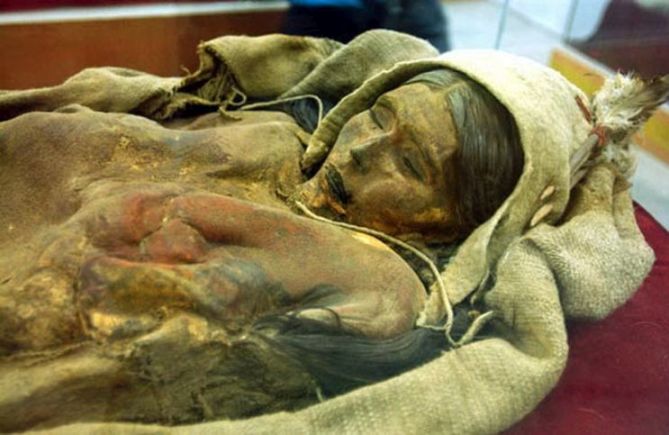The cemetery of the inhabitants of ancient Europe found in the sands of Tibet
In the middle of the Takla-Makan desert in northern Tibet (today it is an autonomous region of Xinjiang), Chinese archaeologists have found an unusual cemetery. Those who created it died four thousand years ago, but their bodies were preserved.This was due to the dry desert air. A similar phenomenon is observed in Egypt, where poor people were buried in the hot sands of the Sahara. The desert air mummified them better than the special balms that were used to preserve the bodies of the pharaohs.
Although we are talking about the East, people buried in Takla Makan have much more in common with the inhabitants of prehistoric Europe – they had dark hair and long noses. They were buried under inverted boats, as the Vikings later did. And those who could afford tombstones were raised on high piles.
We still do not know who these people were from the cemetery in the basin of one of the small rivers flowing into Tarim. Radiocarbon analysis showed that burials there began 3.980 years ago. Scientists are not completely sure either of their origin or of the language they spoke.
Today, Uighurs live in these places, people of Turkic origin who moved here from China. Of course, the discovery of mummies can cause some ethnic tension, since the Uighurs came to these parts in the X century of a new era. This burial ground deprives them of important arguments in a dispute with other immigrants.
Mummies have a very “western appearance”. One of them was nicknamed “Beauty from Lulan”, her DNA was checked back in 2007. Last month, Chinese experts announced that the population of prehistoric Tarim was of mixed origin: their ancestors came from Europe and Siberia, they came to Xinjiang from outside.
Most of the men buried there were carriers of the Y chromosome, which today is characteristic of Eastern Europe, Central Asia and Siberia, but is rare in China.
Mitochondrial DNA is transmitted through the female line, it produced three lines of origin – two from Europe and one from Siberia. Due to the fact that mitochondria and Y chromosomes are old, Chinese experts have come to the conclusion that the Tarim people are the result of a mixture of two groups – European and Siberian in origin. This probably happened over 4,000 years ago.
Initially, a river cemetery was discovered more than 70 years ago – in 1934 – by the Swedish archaeologist Volke Bergman. But they forgot about it until the beginning of the XXI century. Chinese archaeologists conducted research there in 2003-2005. Their reports were subjected to scientific analysis. In particular, they were carefully checked by Victor G. Meyer, a professor at the University of Pennsylvania, an expert on ancient Chinese texts.
According to Mayer, Chinese archaeologists have discovered almost 200 complete burials. Some of the mummies were painted black and red. Above each – a boat turned upside down, covered with cow leather.
The bodies of the dead were in surprisingly good condition – they even preserved some of the clothes: hats with feathers, woolen capes with tassels and leather shoes. Arthur Wolf, an anthropologist at Stanford University, says that thanks to these graves one can determine the structure of social stratification and the status of those buried.
It is significant that in female burials, archaeologists found life-sized wooden male members. Their presence confirms the previously expressed hypothesis that these people had a cult of fertility, expressed in phallic symbols.
On the other hand, as Dr. Mayer added, the experience of living in extreme desert conditions and the high infant mortality rate explain why this people attached so much importance to fertility and offspring. Scientists believe that this group ultimately became extinct due to harsh living conditions. The river on which their survival depended has dried up around 400 CE.
There is still debate about what language people from this burial could speak. Most are inclined to believe that their language could be Tocharian, so they belonged to the dominant Indo-European language family.
This post is also available in:
 English
English  Русский (Russian)
Русский (Russian)






